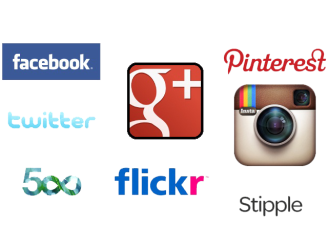When it comes to being a photographer, there is no shortage of online networks waiting for you to share your images, interact with others and potentially grow your business. From Google+ to Facebook, Twitter to Pinterest, 500px to Flickr, you have more options at your disposal now then ever before. But what really is Social Media? Why is it so important? Which networks are best for your needs? And mo
 st importantly, what are some of the ways that you can maximize your time on each of the major networks? Over the next few weeks, I will be releasing a series of posts titled “Social Media for Photographers”. While I will be giving a broad over view of social media here today, each subsequent blog post will cover a specific social network, allowing you to have a more in depth look at the positive and negative aspects of nearly all of the choices out there.
st importantly, what are some of the ways that you can maximize your time on each of the major networks? Over the next few weeks, I will be releasing a series of posts titled “Social Media for Photographers”. While I will be giving a broad over view of social media here today, each subsequent blog post will cover a specific social network, allowing you to have a more in depth look at the positive and negative aspects of nearly all of the choices out there.
As for my background in Social Media, I am a full time photographer and entreprenuer that was fortunate enough to see the writing on the wall when it came to Social Media and Social Networks within the context of the photography industry a few years ago. I currently have just short of 2,000,000 followers on Google+, 126,000 on Facebook, 2,734 on Twitter, 788 followers on Instagram and so on and so forth. This past year I published my first book on Social Media titled (non affiliate link) and I use social media almost purely as my sole source of marketing for my two photography companies, ALLWAYS Photography and I also consult with many of the biggest photography companies in the industry in order to help them better understand and improve their use of social media in a dynamic and changing market. Bottom line, I love social media, I love statistics and I love sharing my knowledge on the subject.
Lets get started…
What is Social Media?
ording to Wikipedia, which I hate using as “source” even if it seems fitting for this subject matter, says that “Social media is web and mobile-based technologies which are use to turn communication into interactive dialogue among organizations, communities and individuals”. To be fair, this definition is pretty spot on. So many people look at Social Media and Social Networks as this incredibly foreign concept, when in reality it is just about giving you the potential to connect and communicate with people around the world. Figuring out what you do with that potential connection, is the challenge. Not every photographer on a social network is there to make money. Some might be looking for inspiration, others for education. Regardless, if you begin to look at social media networks as simply digital platforms that allow you to personally connect with other individuals, your anxiety and uncertainty about jumping in might begin to fade.
The old school methods of marketing and advertising are not only antiquated, they have lost much of their value. Why? Because companies and individuals are beginning to understand that spending $30,000 for an ad to run for a single month in Outdoor Photographer with the hopes of it capturing a potential customers attention for the 1.2 seconds they have to make an impression is not the best use of money anymore. Instead companies are developing full social marketing teams to find ways to connect with new customers in more personal and vital ways than ever before.
Why are Social Networks Important?
If we can all accept the fact that social networks are platforms that give you the chance to connect with individuals from all over the planet, we should know exactly how much potential reach that might include. According to the Internet World Stats website, in 2011 there were 2,267,233,742 active Internet users in the world. This breaks down to roughly 32.7% of the entire population of this planet. Any guesses to how much of a % increase that was from 2000?
If you guessed (or simply looked at the chart above), you would have seen that there was a 528.1% increase in Internet users world wide between 2000 & 2011. That is a pretty staggering number. Some other interesting statistics can be found in this study. North America for example, had roughly 78.6% of its entire population go online, however they only account for 12% of the overall Internet users worldwide. Asia on the other hand had the most Internet users by far with 1,016,799,076, which equated out to 44.8% of all active Internet users, but only 26.1% of the regions total population. Knowing this information will become more relevant later in the blog post. Considering the trajectory of these numbers, one can assume that this trend will only continue to increase as a.) technology continues to advance at break neck speeds b.) the world’s population continues to sky rocket and c.) as a species we continue to become more accustomed to using the Internet in our daily lives.
In the past, one had to spend large sums of money on flyers, advertisements and mailers with the hopes that hopes that those you sent this material cared enough to see it in the first place. Now you have potential access to billions
The Social Age of the Internet
Now to truly understand the importance of Social Media, you need to understand where we are in relation to the lifespan of the Internet. In the last 24 months, we have successfully entered the 3rd generation of the Internet. While the 1st generation had a focus on content with the .Com explosion, the 2nd generation was all about making that content dynamic. A great example of this is the phenomenon that became streaming video (YouTube & Vimeo come to mind). The 3rd generation, where we are presently, is all about trusted content…effectively the “social” age of the net. Now what do I mean by trusted con
W hat Social Networks Are Out There?
hat Social Networks Are Out There?
As I discussed earlier, when it comes to the sheer number of social networks that you as a photographer have access to, the number can be some what intimidating. How many people truly know which networks they should be on or where they should focus their limited time and energy? I imagine that most are simply guessing. So lets do a fairly simple break down of each of the networks, their positive and negative traits and which each Network is good at offering different types of photographers.
